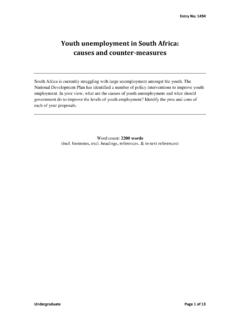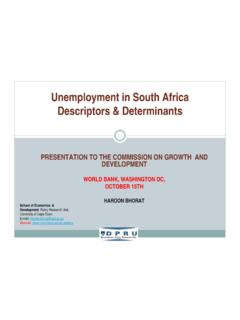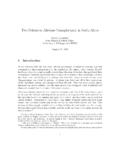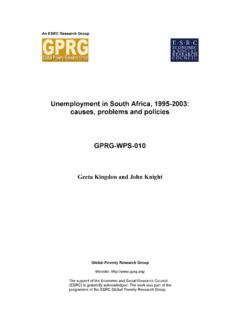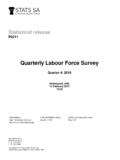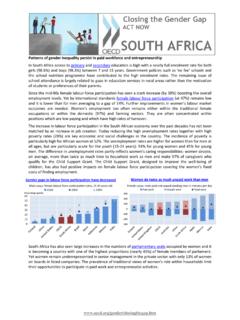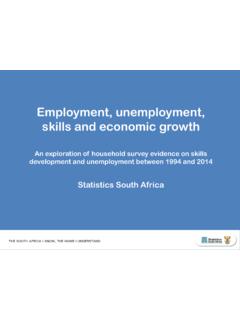Transcription of DISCUSSION PAPER FOR PUBLIC COMMENT
1 DISCUSSION PAPER FOR PUBLIC COMMENT National Treasury Confronting youth unemployment : policy options for south africa DISCUSSION PAPER National Treasury February 2011 2 Contents Executive Summary 4 1. Introduction 7 2. Higher employment for greater inclusion 9 3. An i ntroduction to youth unemployment in south africa 11 4. Confronting youth unemployment : policy options 16 Growth 16 Education 16 Labour market policy 17 Training programmes 18 Direct PUBLIC sector employment 20 Employment services for job search and job matching and sanctions 20 Employment incentives and subsidies 21 Entrepreneurial schemes 22 Comprehensive approach 23 Spending on active labour market policies 23 5.
2 Employment subsidies 25 6. Policy priorities: the argument for a youth employment subsidy 30 7. A youth employment subsidy for south africa 33 8. Conclusion 39 ANNEX A: A youth employment subsidy for south africa 40 A1. Operational and administrative issues 40 A2. Design issues 40 3 i. Eligibility criteria 40 ii. Employment conditions 43 iii. Subsidy duration 43 iv. Subsidy value and profile 45 A3. The potential impact of the youth employment subsidy 46 A4. Evaluating the youth employment subsidy: a primer 50 ANNEX B: Wage subsidy programmes in OECD countries 52 References 53 List of figures, charts, boxes and annexes Fig.
3 1: Youth and adult employment rates in south africa and selected emerging market economies 10 Fig. 2: unemployment rates are much higher for youths (Q3 2010) 11 Fig. 3: Youth (15 24) to adult unemployment ratios compared with the rate of youth unemployment in emerging markets 12 Fig. 4: unemployment rates by age and education, (Q3 2010) 13 Fig. 5: Share of unemployment by age and education, (Q3 2010) 13 Fig. 6: unemployment rates and ranking for how well pay reflects productivity in emerging economies 14 Fig. 7: Employment growth and the employment elasticity of growth, 2004 08 16 Fig. 8: PUBLIC spending on active labour market policies in OECD countries (% of GDP), 2007 24 Fig. 9: Exit rates from unemployment with experience and without experience 31 Table 1: The intensity of unemployment , by age group 12 Table 2: International evidence of wage incentives and employment subsidies 28 Table 3: Estimated cost, job creation and cost per job of the youth employment subsidy over 3 years 37 Box 1: The United Kingdom s New Deal for Youth Employment 24 Box 2: A technical explanation for why an employment subsidy increases job creation 26 Box 3: Poland: Intervention Works Programme 27 Box 4: The International Growth Advisory Panel (IGAP) wage subsidy proposal for south africa 33 Box 5: The proposed design of the youth employment subsidy 36 Annex 4 Fig.
4 : unemployment rate by age, 18 to 34 year olds 42 Fig. : Share of the unemployed with no work experience, by age 42 Fig. : Subsidy profile value and % for new and existing workers qualifying for the subsidy 46 Table : Estimated impact of youth employment subsidy on employment and costs over three years 49 Table : Measuring the quality of intervention (QOI) 50 Table : Measuring the quality of evaluation (QOE) 50 Table B1: Wage subsidy programmes in OECD countries 52 Box A1: An example of a two year duration subsidy 44 Box A2: The wage elasticity 48 5 Confronting youth unemployment : policy options for south africa Executive Summary Introduction south africa has an acute problem of youth unemployment that requires a multi-pronged strategy to raise employment and support inclusion and social cohesion.
5 High youth unemployment means young people are not acquiring the skills or experience needed to drive the economy forward. This inhibits the country s economic development and imposes a larger burden on the state to provide social assistance. The salient facts about youth employment can be summarised as follows1: About 42 per cent of young people under the age of 30 are unemployed compared with less than 17 per cent of adults over 30. Only 1 in 8 working age adults under 25 years of age have a job compared with 40 per cent in most emerging economies. Employment of 18 to 24 year olds has fallen by more than 20 per cent (320 000) since December 2008. Unemployed young people tend to be less skilled and inexperienced almost 86 per cent do not have formal further or tertiary education, while two-thirds have never worked.
6 Why are young people unemployed? There are a number of explanations why young people are unemployed, these include Employers look for skills and experience; they regard unskilled, inexperienced jobseekers as a risky investment. Education is not a substitute for skills. Schooling is not a reliable signal of capabilities, and low school quality feeds into poor workplace learning capacity. Given the uncertainty about the potential of school leavers, employers consider entry-level wages to be too high relative to the risk of hiring these inexperienced workers. A multi-pronged strategy to reduce youth unemployment The New Growth Path calls on the state to provide bold, imaginative and effective strategies to create the millions of new jobs that south Africans need.
7 This requires a combination of initiatives that require direct state involvement, private sector partnerships, as well as the mobilisation of civil society to take a proactive interest in addressing the problems presented by unemployment . To this end, the outcomes-based approach that has been adopted by government identifies the need to develop a multi-pronged strategy to tackle youth unemployment . 1 Quarterly Labour Force Survey for the third quarter of 2010 published by Statistics south africa . 6 Policy options to support youth employment will provide an additional lever for government to create jobs and will not be limited to any particular sector. In certain areas, such as tourism, the New Growth Path already identifies opportunities for youth.
8 These include improving training, as well as identifying employment and entrepreneurial opportunities for youth. Summary of process to develop the multi-pronged strategy to tackle youth unemployment Developing a multi-pronged strategy to tackle youth unemployment is a priority in government s programme of action for 2011/12. Activities that will contribute to developing the multi-pronged strategy include: Reviewing the legislative environment. Identifying the desirable scope and budgetary requirements, of youth brigades and other forms of PUBLIC employment. Conducting a trial of the youth employment subsidy. Improving education performance and skills development in the schooling and further education system.
9 Improving the PUBLIC employment services available to the youth to aid matching of skills, job search, career guidance and counselling, skills development and job placement. Establishing a monitoring system with regular reports on progress. Strengthening relationships with the NYDA and other youth services agencies. Addressing youth unemployment requires both short- and long-term measures that encompass increasing demand for labour, improving education and skills, and labour market interventions that improve the employability of young people. This PAPER highlights various policy options that are available to government but focuses mainly on the youth wage subsidy. The gap between productivity and real wages for young workers is an important constraint to job creation.
10 Skills deficiencies contribute to this gap and make education and skills development a priority for government. Education interventions need to raise the quality of basic and higher education, re-engage drop-outs with the education system and provide an environment that cultivates academic, technical and vocational skills. These interventions will take time to implement and have an effect, particularly given current pass rates and the number of young south Africans that do not complete Grade 12. In the interim, government needs policies that actively integrate young people into the labour market. south africa has a range of labour market policies that can help lower youth unemployment . These focus on improving the employability of the youth (through existing education policies and skills development via the learnership incentive) or provide direct PUBLIC sector employment through EPWP.










